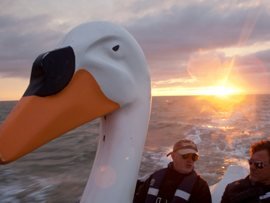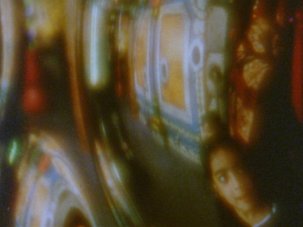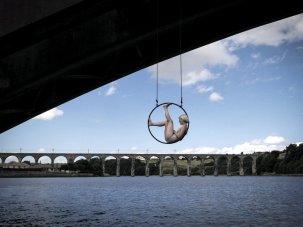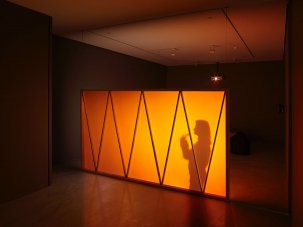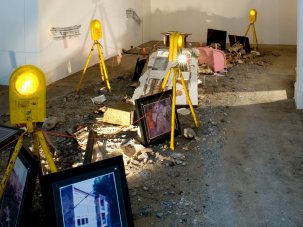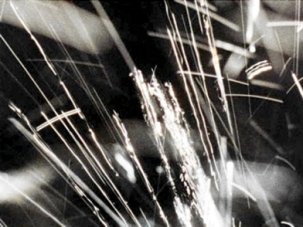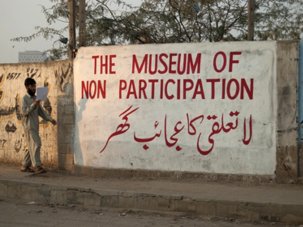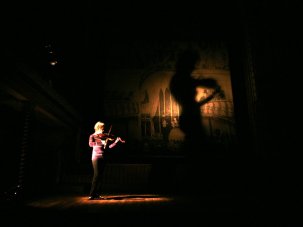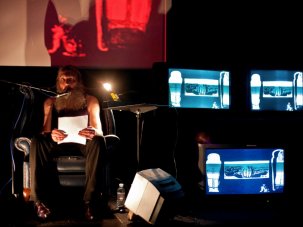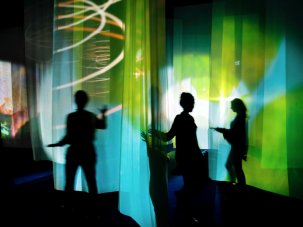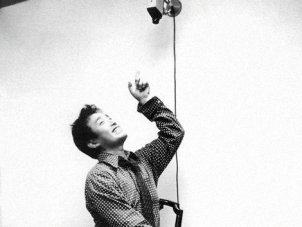Web exclusive

A still from Andrew Kötting’s installation By Our Selves, with Iain Sinclair (left), Toby Jones (right) and the artist as straw bear (centre)
In the Scottish Borders, amongst the rolling countryside of the valley of the Teviot, equidistant from Edinburgh and Newcastle upon Tyne, the town of Hawick (pronounced Hoick) plays host to the annual Alchemy Film and Moving Image Festival, now in its fifth year. Originally a collaboration between Alchemy Film & Arts, Heart of Hawick and Creative Arts Business Network (CABN), the festival brings local and international experimental film and artists’ movies together in the town’s main cinema hub as well as at an assortment of venues and spaces beyond.
Alchemy Film & Moving Image Festival
16-19 April 2015 | Hawick, UK
Alchemy also prides itself on bringing artists and filmmakers to the town, creating an Artists’ Filmmaking Symposium to open the festival, with talks by the likes of Andrew Kötting and fellow Borders curator/programmer Peter Taylor, director of the Berwick Film & Media Arts Festival. Such a rigorous debate- and discussion-led approach to a small-town event was offset by the overwhelmingly friendly attitude of the festival organisers, volunteers and visitors. Presiding over it all was Alchemy’s creative director Richard Ashrowan, himself a widely exhibiting filmmaker with his own Borders-based practice, and a ubiquitous, reassuring presence during the weekend, introducing each screening and performance with his relaxed yet sincere delivery.
The aforementioned assortment of venues turned out to be one of the great curiosities of the festival. Finding spaces for artists’ installations in a small town is surely no mean feat, but each ‘locale’, as they were affectionately designated in the brochure, combined the charms of oddity and inventiveness. One textile mill and another former one, a storage warehouse and an ex-bike shop all hosted installations, but Alchemy’s most curious venue was the Crown Buildings. A former hotel, now business centre and home to various local enterprises including a supported-living service, driving-theory office and Alchemy’s own headquarters, the building is something of a warren, with four floors of narrow corridors and offices around which arrows guided the visitor from one installation to the next; in lieu of offices for community services, doors would open onto artistic explorations of the unconscious, the functionality of chimneys or Yeats’s apocalyptic vision.
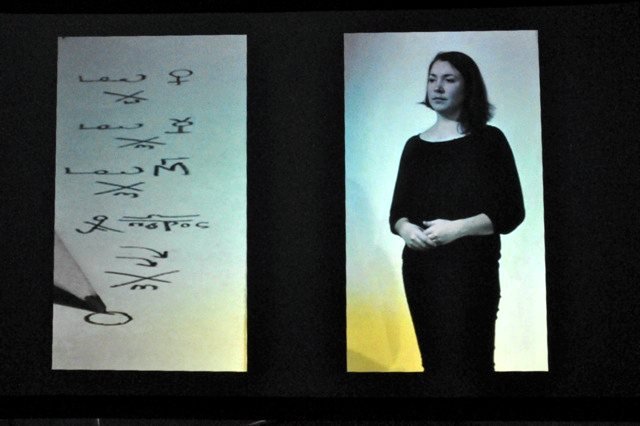
The Leiden Translations (2014)
The strongest of the Crown Building’s installations was the world premiere of Alice Betts’s And the Walls Became the World All Around – in which multiple projections onto ten large floor-to-ceiling paper sheets conveyed the vividness and delicacy of memory – and Alistair Zaldua and Adam Hodgkins’s Leiden Translation (pictured), a two-screen work about the Leiden Papyrus, a third-century text describing processes to improve nature. Zaldua and Hodgkins’s rhythmic looped work combined three forms of translation – British Sign Language, the writing of alchemical sigils and musical interpretation – demonstrating the gesture and physicality of each communicative form.
Elsewhere, Andrew Kötting’s installation By Our Selves featured video and pinhole-camera footage the artist, dressed as a straw bear, shot on an 80-mile walk from Epping Forest to Helpston in Northamptonshire with Iain Sinclair and Toby Jones. Following in the footsteps of the poet John Clare, the trio appear as pilgrims, trekking the land in search of meaning. Alan Moore also turns up, reading Clare’s poem I Am whilst sitting on a bench next to the director. Exploring themes of environmental effect upon mental state, literary articulation of the self and the persistence of artistic influence, the piece was mounted in the appropriately transitory setting of a large self-storage warehouse.
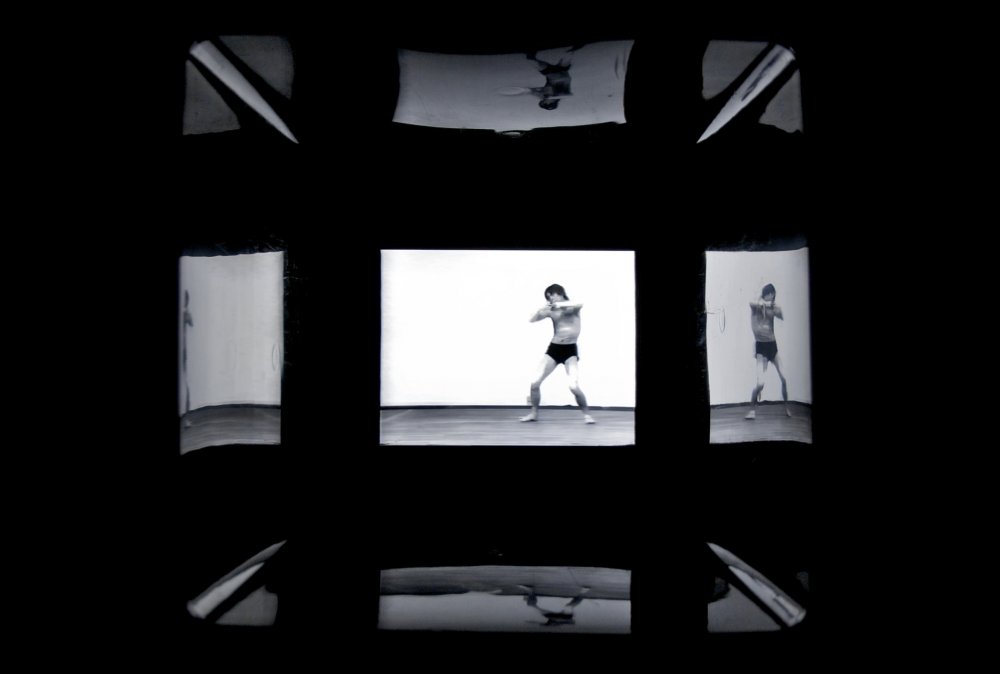
Mairead McClean’s No More (2013), in the festival’s Photoformance shorts programme
Expression of the self was also at the core of Alchemy’s two performances, the first of which was Guy Sherwin’s oft enacted Man with Mirror [Vimeo link]. This piece, in which Sherwin interacts with a filmic image of his younger self, has been performed repeatedly over the years since the artist first recorded its integral footage in 1976 – and with each iteration, Sherwin’s present self appears further distanced from his past. Holding a mirror, one side painted white, the artist stood in front of an 8mm projector from which is projected footage of his 28-year-old self holding a similar mirror. Turning and rotating his mirror in the present, Sherwin appeared enmeshed with the virtual, both ‘bodies’ momentarily distorting into one incomplete self. I’d seen Man with a Mirror performed at arika’s Kill Your Timid Notion festival in 2008; in Hawick on Friday night Sherwin’s manipulation of self-image/presence and illusion of time travel was once again deeply moving.
Also making work about their past selves, musician Angela Tröndle and painter Daniel Domig introduced their Saturday performance Love at First, Second and Third Sight by describing their intention to connect with their teenage days, when the spark of their creative collaboration was first ignited. This nostalgic approach was evident in the performance itself, in which Tröndle’s vocal, synth and looped score accompanied Domig’s paint manipulations, both conveying the intensity and delicacy of love. Using a mash-up of looped pop lyrics (perhaps in a nod to Baz Luhrman’s Moulin Rouge), Tröndle’s impassioned performance perfectly combined with the Chagall-like fragility of Domig’s disappearing figurative animations.
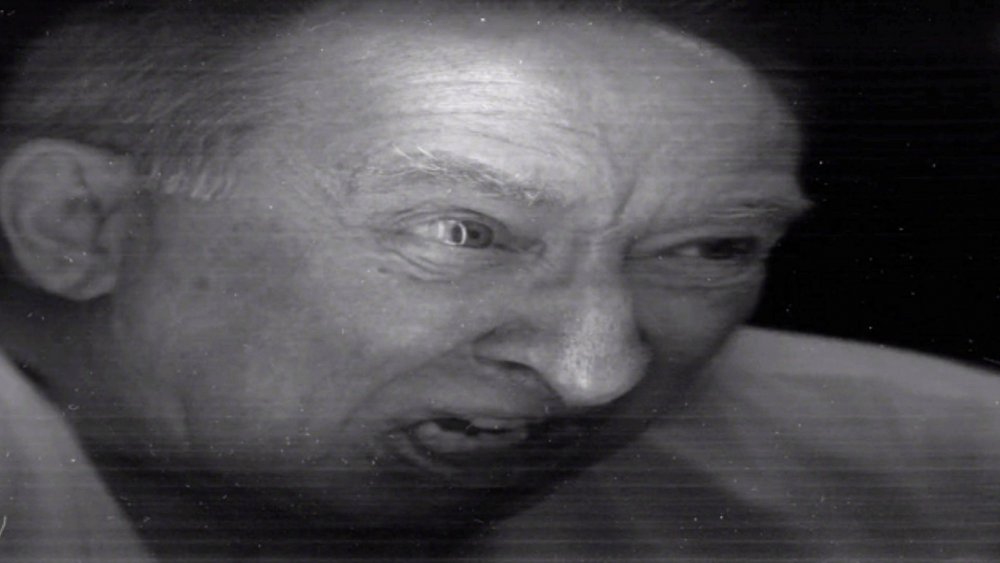
Performance for Perfection (2014)
Other highlights of the festival were the feature and short-film programmes screened at Heart of Hawick – in particular Photoformance, which featured both Mairead McClean’s hugely affecting No More (2013; pictured further up this page) and the world premiere of Ariana Gerstein’s Performance for Perfection (above, 2014), a camera-less film in which the still images created from a tripod-mounted scanner effectively stretch time and the moment of a captured performance. With such a committed, sincere approach to curation within limited means, Alchemy’s unpretentiousness creates a most welcome infectious enthusiasm; long may it continue.
-
The Digital Edition and Archive quick link
Log in here to your digital edition and archive subscription, take a look at the packages on offer and buy a subscription.




